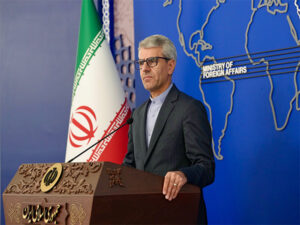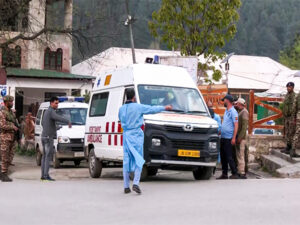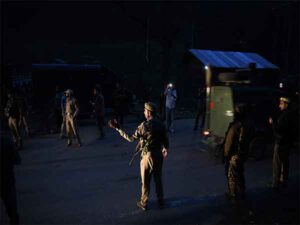Massive solar storm threatens communications and GPS systems
Boulder (Colorado) [US], May 11 (ANI): Prepare yourselves for an extraordinary celestial spectacle set to unfold tonight as a colossal solar storm threatens to disrupt vital communications and GPS systems, ushering in a cosmic event of unprecedented proportions, CNN reported.
The warning came from the highest echelons of the US government, issuing its first severe geomagnetic storm watch in almost two decades. This advisory, a response to the imminent arrival of “at least five earth-directed coronal mass ejections” and sunspots spanning an area 16 times wider than our planet, catapults us into a realm of heightened space weather activity. Dubbed a G4 event, this storm ranks as the second-most severe classification on the US government’s scale.
According to the National Oceanic and Atmospheric Administration (NOAA), the radiation emanating from these solar eruptions began bombarding Earth’s magnetic field on Friday and is slated to persist throughout the weekend. In a startling escalation, NOAA upgraded the storm to a rare G5 or “extreme” classification, a distinction not witnessed since October 2003, as reported by CNN.
The ramifications of such extreme space weather are manifold, potentially unleashing havoc upon technologies integral to modern society. The very fabric of our communications infrastructure, from the power grid to satellite and high-frequency radio transmissions, hangs in the balance.
The crux of the issue lies in the interaction between solar radiation and Earth’s magnetic sphere. As these cosmic emissions collide with our planet’s protective shield, they induce perturbations in the ionosphere, a crucial layer of the upper atmosphere. This atmospheric unrest directly imperils satellites and spacecraft, jeopardising their operational integrity and electronic systems.
Moreover, the ionospheric turbulence poses a grave threat to radio communications, impeding transmissions destined for satellites and impeding the bounce-back of signals. Essential services, including GPS navigation relied upon by the aviation, maritime, agriculture, and energy sectors, teeter on the brink of disruption. Similarly, shortwave radio communications utilised by maritime and aeronautical entities, emergency responders, military units, and amateur radio enthusiasts face potential degradation, amplifying the spectre of operational paralysis.
In a clarion call to action, NOAA’s Space Weather Prediction Centre underscores the far-reaching repercussions of such geomagnetic disturbances, cautioning of conceivable disruptions to infrastructure both in orbit and on terra firma. This admonition prompts proactive measures by system operators to mitigate potential impacts.
While cellular networks predominantly operate on frequencies less susceptible to space weather influences, the integrity of GPS services remains a focal point of concern. The fusion of pure GPS signals with cellular tower-based location tracking offers a semblance of resilience, albeit not impervious to disruption.
Drawing from a 2010 study conducted by NOAA and the Federal Emergency Management Agency (FEMA), researchers assert that even in the throes of an extreme space weather event, direct ramifications on public safety and commercial cellular services remain minimal. This sanguine prognosis hinges on the robustness of underlying electrical infrastructure, which, if unscathed, should shield consumer electronic devices from the storm’s wrath.
Echoing this sentiment, the Cybersecurity and Infrastructure Security Agency underscores the resilience of line-of-sight radio transmissions in the face of space weather vagaries, albeit with caveats regarding terrestrial copper cables and telephone lines.
Despite historical precedents, such as the February solar flares coinciding with reported cellular network outages, NOAA remains circumspect about direct causality. Brent Gordon, chief of the Space Weather Services branch for SWPC, reaffirms this stance, emphasising the indispensable role of a functional power grid in mitigating secondary impacts on cellular services.
The spectre of power grid destabilisation looms large, with NOAA’s alert portending potential voltage control issues and protective system malfunctions. The catastrophic blackout that befell Quebec in 1989 serves as a stark reminder of the grid’s vulnerability to geomagnetic perturbations, with similar incidents unfolding in Sweden and South Africa in recent memory.
Recalling the apocalyptic tableau of the Carrington Event of 1859, wherein telegraph stations ignited in flames, underscores the cataclysmic potential of geomagnetic storms. The cascading effects of a grid blackout, ensnaring cellular towers and data centres, loom ominously on the horizon, imperilling connectivity on an unprecedented scale.
However, fortifications abound within critical infrastructure, with wireless carriers poised to deploy backup power generators and mobile cellular towers in times of crisis. Redundancy and resilience emerge as the linchpins of our technological bulwark, assuaging concerns of systemic collapse in the event of grid failure.
Mirroring preparations for extended power outages, the US government advocates prudent measures to weather the storm. Stockpiling extra batteries, safeguarding electric appliances against surges, and conserving energy resources represent prudent steps in navigating the tempestuous seas of space weather uncertainty.
As the cosmos unfurls its cosmic ballet, humanity stands poised at the precipice of an epoch-defining moment. In the crucible of celestial tumult, the resilience of our technological edifice shall be tested, forging a testament to our capacity to endure and adapt in the face of cosmic adversity, CNN reported.






